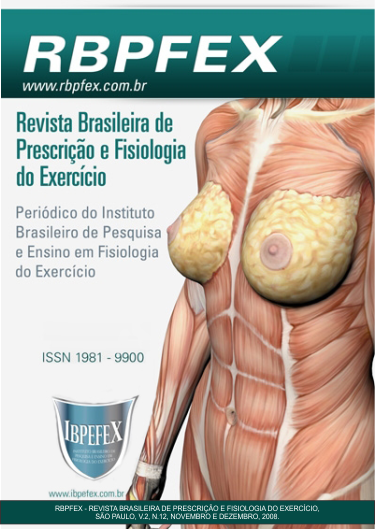Perfil antropométrico de industriários de uma empresa de Joinville praticantes de exercícios físicos
Resumo
Indústrias têm se preocupado com a qualidade de vida de seus funcionários não somente dentro do local de trabalho, mas na sua qualidade de vida fora da empresa que por sua vez interage diretamente no rendimento dos funcionários. O objetivo desse trabalho foi identificar o perfil antropométrico de colaboradores de uma indústria de Joinville do gênero masculino entre 20 e 50 anos. Materiais e métodos: as variáveis mensuradas (massa corporal total, altura, IMC, percentual de gordura, percentual de massa muscular, circunferências de cintura e quadril) neste estudo foram identificadas através de uma avaliação antropometrica, sendo que a densidade corporal foi utilizado o protocolo de Guedes (1998) e o percentual de gordura a fórmula de Siri. Resultados: A amostra foi dividida em 4 grupos 25 mais novos, 25 mais velhos e os 50 intermediários divididos em dois grupos. Observou-se um percentual de 6,04% acima do máximo ficando em 24,4% de gordura. Guedes (1998) propõe um percentual para pessoas ativas de 12 – 18 por cento de gordura. Conclusão: Encontramos assim um nível de sobrepeso na amostra estudada. Concluímos que programas para conscientização de melhorias na qualidade de vida relacionados à nutrição e atividade física fazem-se necessário, conhecimentos a respeito da atividade física no contexto saúde e de cuidados com os hábitos de vida, melhorariam em muito o nível de satisfação destes operários.
Referências
- ACSM. Manual do ACSM para testes de esforço e prescrição de exercício. 5º Edição. Rio de Janeiro: Revinter, 2000.
- ABCS. Applied Body Composition Assessment. Editora Human, pg 82. Kinectics,1996.
- Barros, M.V.G. Atividades físicas no lazer e outros comportamentos relacionados a saúde dos trabalhadores de indústria no estado de Santa Catarina. Dissertação de mestrado UFSC. Florianópolis, 1999.
- Fonseca, J.G.M. Clínica médica: obesidade e outros distúrbios alimentares. Ed. Medsi. Rio de Janeiro, 2001
- Goldberg e Elliot. O poder de cura dos exercícios físicos. Ed., São Paulo, 2001
- Guedes, D.P. Composição corporal, princípios, técnicas e aplicações. Florianópolis, CEITEC, 1990.
- Guedes, D.P.; Guedes, J.E.R.P. Controle do peso corporal: composição corporal, atividade física e nutrição. Londrina: Midiograf, 1980.
- Nahas, M.V. Atividade física, Saúde e Qualidade de vida. Londrina: Midiograf, 2001.
- Siri, W.E. Body composition from fluids spaces and density: Analyses of methods. In: Techniques for measuring body composition, Washington, D C: National Academy of Science and Natural Resource Council, 1961.
- Thomas, J.R.; Nelson, J.K. Métodos de Pesquisa em Atividade Física. Porto Alegre: Artmed, 2002.
- Word Health Organization. The Word health report 2002: reducing risk, promoting healthy life. Word health Organization, Geneva, 2002.
Autores que publicam neste periódico concordam com os seguintes termos:
- Autores mantém os direitos autorais e concedem ao periódico o direito de primeira publicação, com o trabalho simultaneamente licenciado sob a Creative Commons Attribution License BY-NC que permitindo o compartilhamento do trabalho com reconhecimento da autoria do trabalho e publicação inicial neste periódico.
- Autores têm autorização para assumir contratos adicionais separadamente, para distribuição não-exclusiva da versão do trabalho publicada neste periódico (ex.: publicar em repositório institucional ou como capítulo de livro), com reconhecimento de autoria e publicação inicial neste periódico.
- Autores têm permissão e são estimulados a publicar e distribuir seu trabalho online (ex.: em repositórios institucionais ou na sua página pessoal) a qualquer ponto antes ou durante o processo editorial, já que isso pode gerar alterações produtivas, bem como aumentar o impacto e a citação do trabalho publicado (Veja O Efeito do Acesso Livre).






